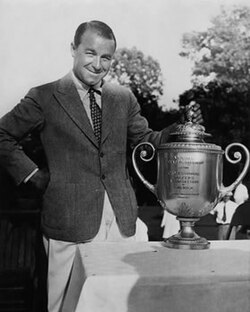History
In November 1954, The Hartford Times sportswriter Charles Stuart "Skip" Henderson, Jr. brought up the idea of creating a state golf Hall of Fame to the Greater Hartford Jaycees. The organization was instituted the following February. [1] The organization was created through a collaboration between the Jaycees and the Connecticut Sports Writers' Alliance. [2] The purpose of the Hall of Fame, it was later described, was to "[recognize] an individual who has state connections, participated in a golf-related activity in Connecticut and has brought honor through golf endeavors at the state, regional, or national levels." [3]
The first induction ceremony was held at the Golf Club of Avon in April 1955. It was held during the third annual Connecticut PGA Spring Golf Show. The selection was completed by the sportswriters of Connecticut. Robert M. Grant was the unanimous choice for the award. [4] Grant was a leading amateur golfer and president of the Connection State Golf Association (CSGA), the New England Golf Association, and Wethersfield Country Club. [5] In 1956, the ceremony began to be held at Wethersfield Country Club after the conclusion of the Insurance City Open, a local PGA Tour event held at the club. The selections continued to be determined by the Connecticut Sports Writers Alliance. [6]
In the early years, the awards' distribution alternated between star professional golfers and obscure local golfers. After Grant's selection, local amateur golfers Charles C. Clare, W.W. "Mike" Sherman, and Frank D. Ross won the award. [6] In 1959, the award went to pathbreaking female golfer Georgianna Bishop. [6] In 1960, electrician and former Connecticut Amateur champion, H.H. Mandly won the award. [7] Following that, legendary golfers Julius Boros and Gene Sarazen won the award consecutively. [8] [9] Immediately thereafter, former U.S. Open champions Billy Burke and Tony Manero earned Hall of Fame honors in respective years. [10] [11]
By the late 1960s, the ceremony moved to Glastonbury Hills Country Club in Glastonbury, Connecticut and then Elmhurst Country Club in East Longmeadow, Massachusetts. [12] [13] During this era, the award was bestowed upon Dr. Ted Lenczyk, a dentist and former Connecticut Open champion, and his sister, Grace Lenczyk Cronin, a star amateur golfer in the 1940s. [13] [14] In the early 1970s, the ceremony returned to the Golf Club of Avon. [15] Despite the changes in location, the awards ceremony was consistently conducted at the annual Connecticut PGA Spring Golf Show. [16] During this era, the event was still sponsored by the Jaycees and the election process was consistently decided by the local sportswriters. [17] In late 1983, however, the ceremony ceased to exist. [18]
In 1991 the awards were "reinstituted." [18] The CSGA, not the sportswriters, now "assumed administration" of the ceremony. [19] During this era, several CSGA executives earned honors. In 1991, former executive for the CSGA, Marty Moraghan, earned the award. "I can't tell you what this means to me," said Moraghan, "to be in the same company as Dick Siderowf and Bobby Grant is something I'll never forget." [20] The following year, Jim Killington, another executive for the association, was inducted. [18] In 1997, former CSGA executive director Russ Palmer was inducted. Palmer was instrumental in merging the CSGA with Connection Section PGA. [21]
In the early 21st century, a number of awards were distributed posthumously to early 20th century golf figures. In 2000 and 2001, the award was dispensed, respectively, to leading 1920s professional Johnny Golden, and the amateur Dick Chapman, former U.S. Amateur and British Amateur champion. [22] [23] In 2005, Skip Henderson, the sportswriter who originated the idea of a Hall of Fame, was selected for the award. [24]

